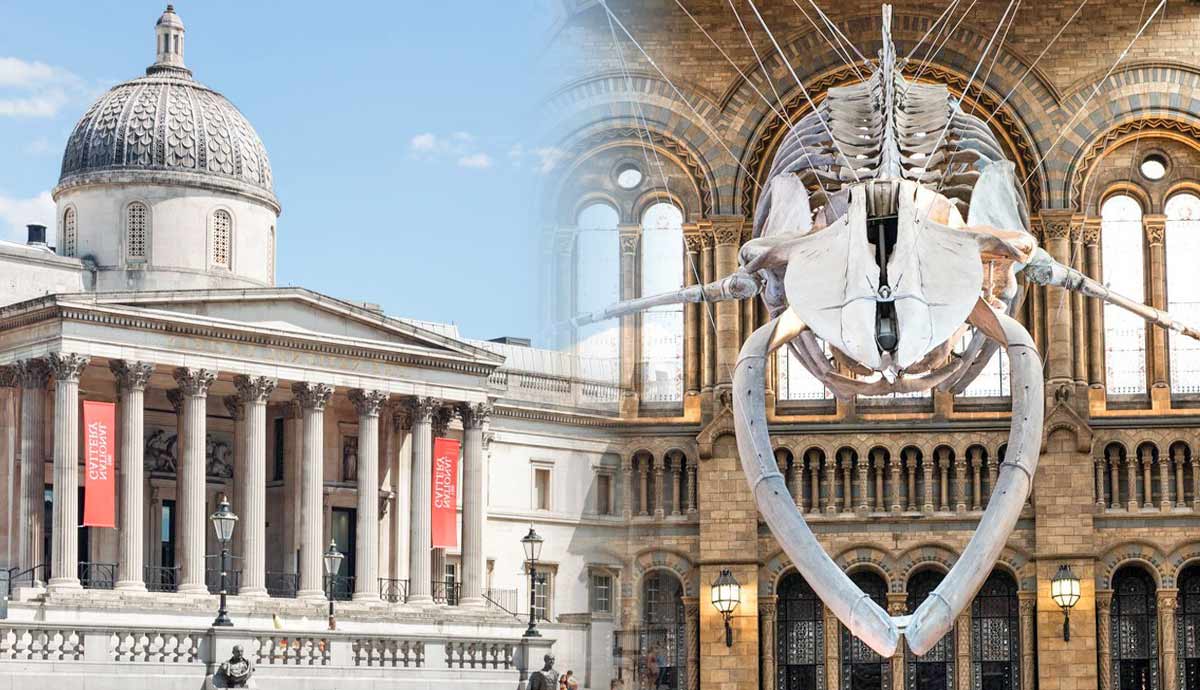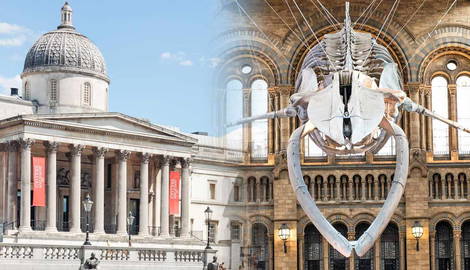
The museum scene in London is one of the finest in the world. Best of all, most museums there are free to enter. In the UK’s capital, museum-goers can learn about global cultures, the history of science, and famous paintings. There’s pretty much everything, from dinosaurs to the future of design. Check out London’s best museums in the list below.
1. London’s First Public Museum: The British Museum

The British Museum was established in 1753. It was the first free national public museum dedicated to world culture. Its vast collection covers all fields of human knowledge. Today, it remains free to all and is one of the most visited museums in the world.
It was based on the collection of Sir Hans Sloane (1660–1753), a physician and the President of the Royal Society who acquired a collection of over 80,000 natural and cultural objects, including tens of thousands of books, manuscripts, coins, and medals. After his death, his collection became the foundation of the British Museum, along with objects from the Royal, Cotton, and Harley Libraries. In the two and half centuries since it opened its doors, the British Museum has grown its holdings to include around 8 million objects covering two million years of human history and culture. The British Museum is home to some of the most important artifacts ever discovered, including the Rosetta Stone. The museum’s collection represents every corner of the globe, and its fascinating holdings, in particular its collection of Egyptian antiquities and the Parthenon Sculptures, draw in millions of annual visitors.
2. The Natural History Museum

At the Natural History Museum visitors can travel through 4.6 billion years of history. Covering all aspects of the natural world, the museum is dedicated to the exploration of the history of the planet, nature, and the origins of the universe itself. The collection contains a staggering 80 million objects. Its vast remit includes dinosaurs, wildlife, botany, human evolution, geology, space, and the oceans, among other things. It is also a functioning scientific institution where the members of the scientific community study the collection in an attempt to answer questions about the solar system, our planet, and life on Earth.
The museum is particularly well known for its impressive paleontological holdings and its dinosaur-themed displays, delighting curious children from all over the world. London’s Natural History Museum is not only one of London’s most popular attractions but one of the most visited museums in Europe. It is situated in South Kensington, which is home to several of London’s top museums.
3. The National Gallery

The 200-year-old National Gallery houses the national collection of paintings from the 13th to the 19th centuries. The museum’s relatively modest collection of 2,300 works contains some of the world’s most famous pictures created in the Western European tradition, spanning almost seven centuries from medieval art to the dawn of Impressionism. The National Gallery’s collection of Renaissance works includes paintings by some of the most famous artists in history, such as Leonardo da Vinci, Titian, and Raphael. It also holds a superb collection of Dutch masterpieces, including the famous Arnolfini Portrait by Jan van Eyck. Some of the most popular works at the National Gallery are its Impressionist and Post-Impressionist works, including Vincent van Gogh’s Sunflowers and Claude Monet’s Waterlilies. Located in the heart of London in the iconic Trafalgar Square, the National Gallery is often the backdrop to national events.
4. Tate

There are two Tate galleries in London: Tate Modern and Tate Britain. The world-famous Tate Modern sits on the south bank of the River Thames opposite St Paul’s Cathedral. Housed in a former power station, the museum is a veritable newbie on the London museum scene. It opened in 2000. Despite its young life, the museum is already considered a legendary place for art lovers and it is one of the most popular museums in the city.
As its name suggests, Tate Modern is home to the nation’s collection of international modern and contemporary art. Its collection includes artworks from all over the globe and features works made by the biggest names of the 20th and 21st centuries. Pablo Picasso, Andy Warhol, Henri Matisse, and Edgar Degas are just a few of the artists represented here.
Tate Britain houses the nation’s collection of British art. After Henry Tate, a sugar magnate, donated his collection to the National Gallery in 1889, a new building was required to display the nation’s holdings of British drawings, paintings, and sculptures. A site on the river just west of the Parliament was chosen. Officially known as the National Gallery of British Art, it soon became known colloquially as the Tate Gallery. More than half a century later, in 1954 it was separated from the National Gallery to become a museum in its own right. Today, it’s home to British art from 1500 to the present day and includes works by the best of British artists including Thomas Gainsborough, John Constable, JMW Turner, Lucien Freud, Barbara Hepworth, Bridget Riley, and David Hockney.
5. The V&A

The Victoria and Albert Museum is more commonly known as the V&A. It is located in London’s museum quarter in South Kensington. It was named after Queen Victoria and her husband, Albert, who was a dedicated patron of the arts.
The Victoria and Albert Museum was established in 1852 and was originally known as the South Kensington Museum. The V&A celebrates art and design and its collection spans 5,000 years of human creativity. Its holdings cover a vast array of objects including antiquities, furniture, clothing, manuscripts, paintings, and jewelry. The collection represents all major periods and styles of art such as the art of ancient China, the Renaissance, gothic, baroque, Art Deco, Art Nouveau, and postmodernism, among others. It is a true treasure trove where visitors can explore the breadth of humanity’s creativity.
6. The Science Museum

The Science Museum was founded in 1862 when the science collection from the South Kensington Museum, now the V&A, was moved to a separate building on the same road (Exhibition Road in South Kensington). The origins of both museums lie in the Great Exhibition of 1851. The exhibition was organized by Prince Albert and was the world’s first international display of design and manufacturing. Following its success, Prince Albert sought to maintain and improve British industry standards and spearheaded the development of a cultural district of museums and educational institutions dedicated to art and science education. Today, the Science Museum cares for a world-class collection that acts as a record of global scientific, technological, and medical progress and advancement.
7. The Design Museum

Devoted to contemporary design in all its forms, the Design Museum in London celebrates mediums including architecture, fashion, graphics, product, and industrial design. It was founded in 1989 and is a space where the design industry, education sector, and the public come together to shape the way people think about the future. It was originally housed in an old banana warehouse in east London, but it was moved to Kensington in 2016, close to London’s museum quarter. The Design Museum’s collection forms a record of the designs that have shaped the modern world. Visitors can explore the history of mass production, 19th-century innovations, and the contemporary digital revolution.
8. Royal Museums Greenwich

The Royal Museums Greenwich is a collection of four museums: The Royal Observatory, the National Maritime Museum, the Queen’s House, and The Cutty Sark. Together, they tell the story of the UK’s advances in astronomical observations, maritime history, and the royal connection with Greenwich. They are situated in and around Greenwich Park in southeast London. In the 1400s, Europeans began to sail around the globe, exploring the world and building trading networks. The need for ever-more-reliable astronomical information, required to aid navigation and timekeeping, led to the establishment of The Royal Observatory.
The observatory is home to the Prime Meridian where Greenwich Mean Time (GMT) begins. The National Maritime Museum charts the history of maritime exploration in the Age of Discovery and Britain’s relationship with the oceans. The Cutty Sark is a celebrated former sailing ship that was the fastest of its time. It is now open to the public as a museum. The Queen’s House was built for Anne of Denmark, wife of King James I in 1613. Today it is home to an internationally renowned art collection, including The Armada Portrait of Elizabeth I.
9. National Portrait Gallery

Located next to (and often confused with) the National Gallery, London’s National Portrait Gallery is home to the nation’s collection of portraiture. Celebrating the capturing of the human image, the National Portrait Gallery showcases portraiture in all its forms, including drawings, paintings, sculpture, and photography. The collection includes over 220,000 works and covers the period from the 16th century to the present day. Famous artists and famous faces grace the walls of the Gallery. There are images of well-known figures, from Tudor monarchs to modern-day celebrities, alongside unknown sitters, preserved in perpetuity. King Henry VIII, William Shakespeare, Audrey Hepburn, Muhammad Ali, and John Lennon all have a place in the National Portrait Gallery’s collection.
10. An Intimate London Museum: The Wallace Collection

The Wallace Collection is housed in a historic building in the center of London. The collection includes masterpieces of painting, sculpture, arms and armor, and decorative arts. The works were once owned by the Wallaces, an aristocratic British family. The family bequeathed the collection to the nation in 1897 and it is on display in their former London residence.
The Wallace Collection includes outstanding holdings of French 18th-century art, including Jean-Honoré Fragonard’s iconic The Swing. It also includes important European paintings from the 17th and 19th centuries, and medieval and Renaissance works. Some of its highlights include Frans Hals’ The Laughing Cavalier, Titian’s Perseus and Andromeda, and Diego Velázquez’s Lady with a Fan. It is also known as one of the best collections of arms and armor in Britain.











